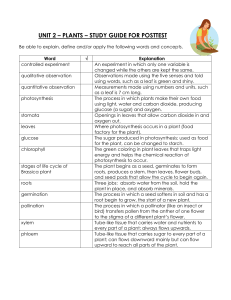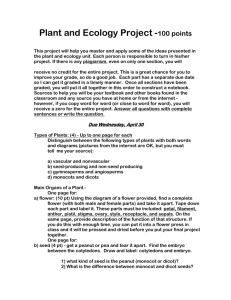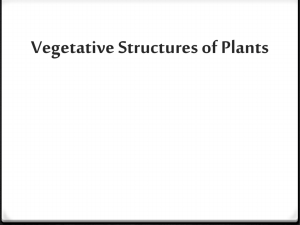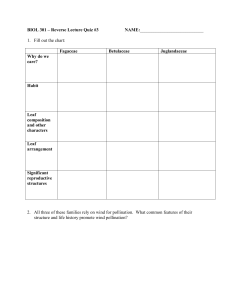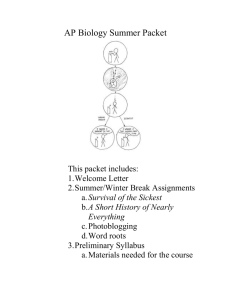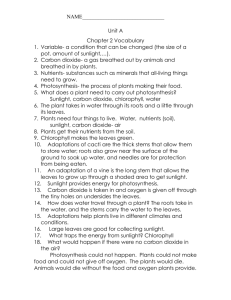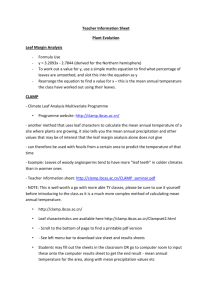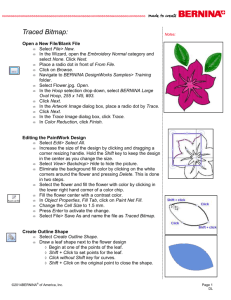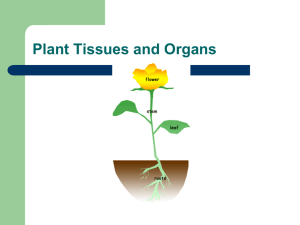Commercial Horticulture Production Week 1 Plant Science
advertisement
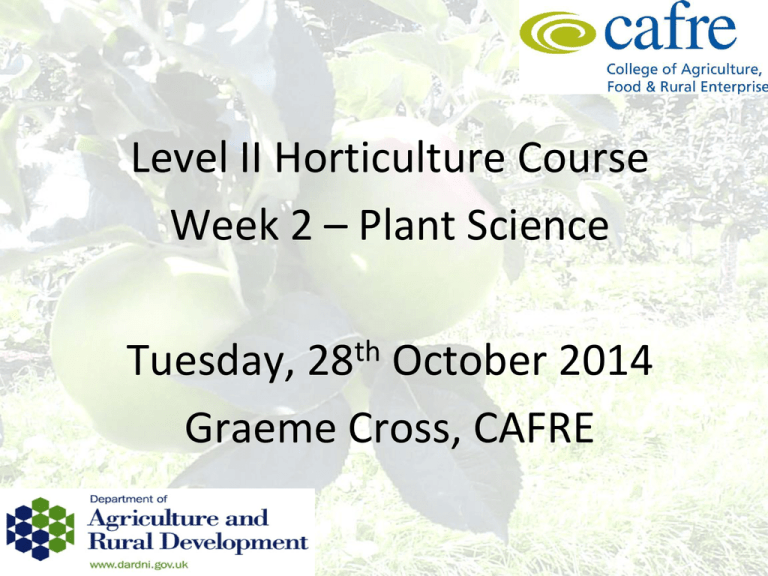
Level II Horticulture Course Week 2 – Plant Science Tuesday, 28th October 2014 Graeme Cross, CAFRE Tonight’s Course Content: • Plant Structures • Plant Processes • Plant Development Plant Structures • Scientists like to classify and name things! • What are the parts of a plant? • Leaves, stems/shoots, roots, flowers, seeds, fruits • Why are these plant parts significant? • All have different roles / functions Plant Structures & Functions Leaf:photosynthesis & transpiration Stem/shoot: support & water movement Root: support/anchorage & water/nutrient uptake Flower: pollination (reproduction) Seed (fruit/nut): new generation (reproduction) LEAVES The home of photosynthesis: the means by which energy is captured from sunlight for plant growth and storage Carbon dioxide + water = sugar + oxygen CO2 + H20 = C6H12O6 + O2 Carbon dioxide + water = sugar + oxygen CO2 + H20 = C6H12O6 + O2 LEAF COMPLEXITY A simple leaf Compound Leaves LEAF AREA INDEX (L.A.I.) A calculation (measurement) of the total coverage that plant foliage creates for the interception (capture) of available light. Of all the energy emitted from the sun, we can only see what is called the “visible spectrum”. This is also the range in which plants absorb energy through photosynthesis. Different pigments in plants (e.g chlorophyll) absorb different wavelengths of light. FACTORS INFLUENCING PHOTOSYNTHESIS • • • • • Carbon dioxide Light Temperature Water (opening & closing of stomata) Health of the leaves - nutrition A NOTE ON LEAF HEALTH (NUTRITION) Mineral deficiencies (shortage of essential nutrients) can lead to poor colour of the leaf (pigmentation) and so reduce ‘performance’. SHOOTS These structural supports are formed from strong, fibrous tissues arranged in bundles to carry weight and resist damage from wind and animal feeding. They also contain the transport system for the plant WHAT IS RESPIRATION? This process of respiration is the reverse to photosynthesis i.e. It is the conversion of sugars into energy for life (growth, reproduction, etc.) Sugar + oxygen => Carbon dioxide + water C6H12O6 => CO2 + + O2 H20 RESPIRATION : KEY POINTS • Occurs all the time (and not dependent on light levels) • Takes place in every living cell (inc. roots) • Requires oxygen, so anaerobic conditions are bad! • temperature = respiration = growth rate • High respiration in stores is not recommended Why is this? ROOTS A network of specialist tissues for the anchorage of plants in the soil or medium on which they grow. Roots also act to uptake water and dissolved nutrients. TRANSPIRATION The movement of water from soil through root tips to the leaf and hence through the whole body of the plant Mature tree may lose 70-100 l/hr in daylight FLOWER A specialist structure which allows the transfer of pollination between plants and creates seed for the next generation. POLLINATION The transfer of pollination between male and female reproductive parts of flower(s) which leads to fertilisation. How is pollen transferred between flowers? FERTILISATION The fusion of the two gametes (the pollen from male and the ovum from female) within the flower, to form a new seed SEEDS / FRUITS / NUTS The structures which allow the germination of a new generation of plants (= embryo plants + food reserve) PLANT HORMONES Specific chemical compounds which are produced naturally within the plant’s own tissues to regulate the growth of new organs and parts. Some Named Plant Hormones Auxins Cytokinins Gibberrellins Ethylene (Ethene) Abscisic acid AUXINS Indole-acetic acid (IAA), Napthyl acetic acid (NAA) Used in Rooting Powder Auxins encourage roots and discourage shoots CYTOKININS Work in combination with auxins to control the extent and direction of shoot (stem) growth (“Apical Dominance”) GIBERRELINS Involved in a range of growth responses such as flower and fruit formation, seed development EHTHYLENE (ETHENE) A simple gas (C2H4) which controls the maturation of fruits and the aging process in fruits and flowers ABSCISIC ACID (ABA) A single carbon compound which triggers a range of responses such as dormancy, maturation, leaf fall, cell division. 1. Seed (sown) 2. Germination / seedling 3. Young plant / vegetative phase 4. Established flowering plant 5. Mature / Harvest plant CROP GROWTH STAGES IN CEREALS 1 2 3 4 5 6 7 8 9 Seedling development (leaves). Tillering. Stem elongation. Booting (developing head inside sheath). Heading (ear emerging). Flowering (anthers visible). Milk (grains soft and milky). Dough (grains firm and doughy) Ripening (grains hard). Zadok’s Cereal Growth Stages Potato Growth Stages IDENTIFY THE GROWTH STAGES Seedling / Young Plant Established/ Flowering plant Mature / harvest / senescent plant
